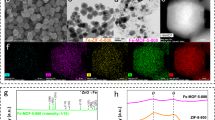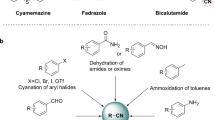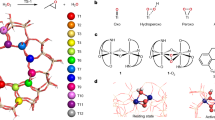Abstract
Iron-containing zeolites are heterogeneous catalysts that exhibit remarkable activity in the selective oxidation of inert hydrocarbons and catalytic decomposition of nitrous oxide (N2O). The reduction of N2O is critical to both these functions, but experimental data tracking the iron active sites during N2O binding and activation are limited. Here, the N2O-ligated Fe(ii) active site in iron-exchanged zeolite beta is isolated and characterized by variable-temperature Mössbauer, diffuse reflectance UV-vis-NIR and Fourier transform infrared spectroscopy. N2O binds through the terminal nitrogen atom with substantial backbonding from the Fe(ii) centre at low temperature. At higher temperatures, the Fe–N2O interaction is weakened, facilitating isomerization to the O-bound form, which is competent in O-atom transfer. Density functional theory calculations show the geometric and electronic structure requirements for N2O binding and activation. A geometric distortion imposed by the zeolite lattice plays an important role in activating N2O. This highlights a mechanism for structural control over function in Fe-zeolite catalysts.

This is a preview of subscription content, access via your institution
Access options
Access Nature and 54 other Nature Portfolio journals
Get Nature+, our best-value online-access subscription
$29.99 / 30 days
cancel any time
Subscribe to this journal
Receive 12 digital issues and online access to articles
$119.00 per year
only $9.92 per issue
Buy this article
- Purchase on Springer Link
- Instant access to full article PDF
Prices may be subject to local taxes which are calculated during checkout







Similar content being viewed by others
Data availability
Additional data are available in the Supplementary Methods and Supplementary Data. Any unavailable data that support the findings of this study can be requested from the authors. See the author contributions for specific datasets.
References
IPCC Climate Change 2013: The Physical Science Basis (eds Stocker, T. F. et al.) (Cambridge Univ.Press, 2013).
Tolman, W. B. Binding and activation of N2O at transition‐metal centers: recent mechanistic insights. Angew. Chem. Int. Ed. 49, 1018–1024 (2010).
Paulat, F. et al. Spectroscopic properties and electronic structure of pentammineruthenium(ii) dinitrogen oxide and corresponding nitrosyl complexes: binding mode of N2O and reactivity. Inorg. Chem. 43, 6979–6994 (2004).
Pamplin, C.B., Ma, E.S. F., Safari, N., Rettig, S.J. & James, B.R. The nitrous oxide complex, RuCl2(η1-N2O)(P-N)(PPh3) (P-N = [o-(N,N-dimethylamino)phenyl]diphenylphosphine); low temperature conversion of N2O to N2 and O2. J. Am. Chem.Soc. 123, 8596–8597 (2001).
Piro, N. A., Lichterman, M. F., Harman, W. H. & Chang, C. J. A structurally characterized nitrous oxide complex of vanadium. J. Am. Chem. Soc. 133, 2108–2111 (2011).
Xiao, D. J. et al. Oxidation of ethane to ethanol by N2O in a metal–organic framework with coordinatively unsaturated iron(ii) sites. Nat. Chem. 6, 590–595 (2014).
Panov, G. I., Sobolev, V. I. & Kharitonov, A. S. The role of iron in N2O decomposition on ZSM-5 zeolite and reactivity of the surface oxygen formed. J. Mol. Catal. 61, 85–97 (1990).
Snyder, B. E. R. et al. The active site of low-temperature methane hydroxylation in iron-containing zeolites. Nature 536, 317–321 (2016).
Kondratenko, E. V. & Pérez-Ramírez, J. Mechanism and kinetics of direct N2O decomposition over Fe-MFI zeolites with different iron speciation from temporal analysis of products. J. Phys. Chem. B 110, 22586–22595 (2006).
Zecchina, A., Rivallan, M., Berlier, G., Lamberti, C. & Ricchiardi, G. Structure and nuclearity of active sites in Fe-zeolites: comparison with iron sites in enzymes and homogeneous catalysts. Phys. Chem. Chem. Phys. 9, 3483–3499 (2007).
Liu, N. et al. Charge transfer analysis on the direct decomposition of nitrous oxide over Fe-BEA zeolite: an experimental and density functional study. J. Phys. Chem. C 115, 12883–12890 (2011).
Chen, B. et al. Study on the direct decomposition of nitrous oxide over Fe-beta zeolites: from experiment to theory. Catal. Today 175, 245–255 (2011).
Berlier, G. et al. Evolution of extraframework iron species in Fe silicalite. J. Catal. 208, 64–82 (2002).
Rivallan, M., Ricchiardi, G., Bordiga, S. & Zecchina, A. Adsorption and reactivity of nitrogen oxides (NO2, NO, N2O) on Fe-zeolites. J. Catal. 264, 104–116 (2009).
Wood, B. R., Reimer, J. A. & Bell, A. T. Studies of N2O adsorption and decomposition on Fe-ZSM-5. J. Catal. 209, 151–158 (2002).
Wang, Y., Lei, Z., Chen, B., Guo, Q. & Liu, N. Adsorption of NO and N2O on Fe-BEA and H-BEA zeolites. Appl. Surf. Sci. 256, 4042–4047 (2010).
Krebs, C., Fujimori, D. G., Walsh, C. T. & Bollinger, J. M. Non-heme Fe(iv)-oxo intermediates. Acc. Chem. Res. 40, 484–492 (2007).
Price, J. C., Barr, E. W., Tirupati, B., Bollinger, J. M. & Krebs, C. The first direct characterization of a high-valent iron intermediate in the reaction of an α-ketoglutarate-dependent dioxygenase: a high-spin Fe(iv) complex in taurine/α-ketoglutarate dioxygenase (TauD) from Escherichia coli. Biochemistry 42, 7497–7508 (2003).
Eckhause, M., Harris, R. J., Shuler, W. B. & Welsh, R. E. A measurement of the lifetime of the 14.4-kev level of 57Fe. Proc. Phys. Soc. 89, 187–188 (1966).
Brozek, C. K., Ozarowski, A., Stoian, S. A. & Dincă, M. Dynamic structural flexibility of Fe-MOF-5 evidenced by 57Fe Mössbauer spectroscopy. Inorg. Chem. Front. 4, 782–788 (2017).
Shimanouchi, T. Tables of molecular vibrational frequencies. Consolidated volume II. J. Phys. Chem. Ref. Data 6, 993–1102 (1977).
Göltl, F. et al. Computationally exploring confinement effects in the methane-to-methanol conversion over iron–oxo centers in zeolites. ACS Catal. 6, 8404–8409 (2016).
Snyder, B. E. R., Vanelderen, P., Schoonheydt, R. A., Sels, B. F. & Solomon, E. I. Second-sphere effects on methane hydroxylation in Cu-zeolites. J. Am. Chem. Soc. 140, 9236–9243 (2018).
Snyder, B. E. R. et al. Structural characterization of a non-heme iron active site in zeolites that hydroxylates methane. Proc. Natl Acad. Sci. USA 115, 4565–4570 (2018).
Bols, M. L. et al. Spectroscopic identification of the α-Fe/α-O active site in Fe-CHA zeolite for the low-temperature activation of the methane C–H bond. J. Am. Chem. Soc. 140, 12021–12032 (2018).
Clark, M. G., Bancroft, G. M. & Stone, A. J. Mössbauer spectrum of Fe2+ in a square‐planar environment. J. Chem. Phys. 47, 4250–4261 (1967).
Panov, G. I., Sheveleva, G. A., Kharitonov, A. S., Romannikov, V. N. & Vostrikova, L. A. Oxidation of benzene to phenol by nitrous oxide over Fe-ZSM-5 zeolites. Appl. Catal. A Gen. 82, 31–36 (1992).
Sobolev, V. I. et al. Catalytic properties of ZSM-5 zeolites in N2O decomposition: the role of iron. J. Catal. 139, 435–443 (1993).
Kiwi-Minsker, L., Bulushev, D. A. & Renken, A. Low temperature decomposition of nitrous oxide over Fe/ZSM-5: modelling of the dynamic behaviour. Catal. Today 110, 191–198 (2005).
Wood, B. R., Reimer, J. A., Bell, A. T., Janicke, M. T. & Ott, K. C. Nitrous oxide decomposition and surface oxygen formation on Fe-ZSM-5. J. Catal. 224, 148–155 (2004).
Pidko, E. A. Toward the balance between the reductionist and systems approaches in computational catalysis: model versus method accuracy for the description of catalytic systems. ACS Catal. 7, 4230–4234 (2017).
Tolman, W. B. Binding and activation of N2O at transition-metal centers: recent mechanistic insights. Angew. Chem. Int. Ed. 49, 1018–1024 (2010).
Snyder, B. E. R., Bols, M. L., Schoonheydt, R. A., Sels, B. F. & Solomon, E. I. Iron and copper active sites in zeolites and their correlation to metalloenzymes. Chem. Rev. 118, 2718–2768 (2018).
Hallaert, S. D. et al. Identification of α-Fe in high-silica zeolites on the basis of ab initio electronic structure calculations. Inorg. Chem. 56, 10681–10690 (2017).
Tsai, M. L. et al. [Cu2O]2+ active site formation in Cu-ZSM-5: geometric and electronic structure requirements for N2O activation. J. Am. Chem. Soc. 136, 3522–3529 (2014).
Marcus, R. A. Theoretical relations among rate constants, barriers, and Brønsted slopes of chemical reactions. J. Phys. Chem. 72, 891–899 (1968).
Woertink, J. S. et al. A [Cu2O]2+ core in Cu-ZSM-5, the active site in the oxidation of methane to methanol. Proc. Natl Acad. Sci. USA 106, 18908–18913 (2009).
Baerlocher, C. & McCusker, L. B. Database of Zeolite Structures (IZA-SC, accessed 25 April 2017); http://www.iza-structure.org/databases/
Becke, A. D. Density-functional exchange-energy approximation with correct asymptotic behavior. Phys. Rev. A 38, 3098–3100 (1988).
Lee, C., Yang, W. & Parr, R. G. Development of the Colle–Salvetti correlation-energy formula into a functional of the electron density. Phys. Rev. B 37, 785–789 (1988).
Grimme, S., Antony, J., Ehrlich, S. & Krieg, H. A consistent and accurate ab initio parametrization of density functional dispersion correction (DFT-D) for the 94 elements H–Pu. J. Chem. Phys. 132, 154104 (2010).
Perdew, J. P., Burke, K. & Ernzerhof, M. Generalized gradient approximation made simple. Phys. Rev. Lett. 77, 3865–3868 (1996).
Kresse, G. & Hafner, J. Ab initio molecular dynamics for liquid metals. Phys. Rev. B 47, 558–561 (1993).
Kresse, G. & Hafner, J. Ab initio molecular-dynamics simulation of the liquid-metalamorphous-semiconductor transition in germanium. Phys. Rev. B 49, 14251–14269 (1994).
Kresse, G. & Furthmüller, J. Efficient iterative schemes for ab initio total-energy calculations using a plane-wave basis set. Phys. Rev. B 54, 11169–11186 (1996).
Van Speybroeck, V. et al. Advances in theory and their application within the field of zeolite chemistry. Chem. Soc. Rev. 44, 7044–7111 (2015).
Ghysels, A., Verstraelen, T., Hemelsoet, K., Waroquier, M. & Van Speybroeck, V. TAMkin: a versatile package for vibrational analysis and chemical kinetics. J. Chem. Inf. Model. 50, 1736–1750 (2010).
Vandevondele, J. et al. Quickstep: fast and accurate density functional calculations using a mixed Gaussian and plane waves approach. Comput. Phys. Commun. 167, 103–128 (2005).
Heyden, A., Bell, A. T. & Keil, F. J. Efficient methods for finding transition states in chemical reactions: comparison of improved dimer method and partitioned rational function optimization method. In AIChE Annual Meeting, Conference Proceedings Vol. 123, 11531 (American Institute of Physics, 2005).
Henkelman, G. & Jónsson, H. Improved tangent estimate in the nudged elastic band method for finding minimum energy paths and saddle points. J. Chem. Phys. 113, 9978–9985 (2000).
Frisch, M. J. et al. Gaussian 09, Revision D.01 (Gaussian, 2009).
Neese, F. The ORCA program system. WIREs Comput. Mol. Sci. 2, 73–78 (2012).
Neese, F. Prediction and interpretation of the 57Fe isomer shift in Mössbauer spectra by density functional theory. Inorg. Chim. Acta 337, 181–192 (2002).
Acknowledgements
This investigation has been supported by the Flemish Science Foundation (FWO, grant no. G0A2216N to B.F.S. and R.A.S.) and the National Science Foundation (grant no. CHE-1660611 to E.I.S.). B.E.R.S. acknowledges support from the National Science Foundation Graduate Research Fellowship Program under grant no. DGE-11474 and from the Munger, Pollock, Reynolds, Robinson, Smith & Yoedicke Stanford Graduate Fellowship. M.L.B. acknowledges the Research Foundation–Flanders for funding of his stay at Stanford University (grant no. V417018N). E.I.S. acknowledges support from the Stanford Woods Institute for the Environment. P.C. and V.V.S. acknowledge the Research Board of Ghent University (BOF) and funding from the European Union’s Horizon 2020 research and innovation programme (consolidator ERC grant agreement no. 647755–DYNPOR (2015–2020)). The work by G.W. was supported by the ANR-Total ‘Nanoclean Energy’ chair and Normandy’s RIN program. The computational resources and services for the periodic calculations were provided by Ghent University (Stevin Supercomputer Infrastructure) and the VSC (Flemish Supercomputer Centre), funded by the Research Foundation–Flanders (FWO).
Author information
Authors and Affiliations
Contributions
M.L.B., B.E.R.S., B.F.S., E.I.S. and R.A.S. designed the experiments. M.L.B., B.E.R.S. and H.M.R. performed the experiments. G.F. performed the FTIR experiments. B.E.R.S. performed the cluster DFT calculations. P.C. and V.V.S. performed the periodic DFT calculations. M.L.B., B.E.R.S., H.M.R., P.C., V.V.S., B.F.S. and E.I.S. analysed the data. M.L.B., B.E.R.S. and H.M.R. wrote the manuscript with guidance from R.A.S., E.I.S. and B.F.S.
Corresponding authors
Ethics declarations
Competing interests
The authors declare no competing interests.
Additional information
Peer review information Nature Catalysis thanks Dennis Palagin and the other, anonymous, reviewer(s) for their contribution to the peer review of this work.
Publisher’s note Springer Nature remains neutral with regard to jurisdictional claims in published maps and institutional affiliations.
Extended data
Extended Data Fig. 1 Comparison of the six possible N2O-bound models.
The models are evaluated by cluster DFT calculations. It is not possible to bind additional N2O ligands to the sterically protected trans axial positions of these sites. In the table, the predicted properties of these models are compared. DFT calculations predict S = 2 ground states for all six models. Based on their predicted quadrupole splittings, the η1-O,O/η1-O,N models are potential structural models of the α-(N2O)2 LT2 species observed at low temperature and high N2O concentrations (see Fig. 1f). Values of ΔHads,298K and ΔEel,ads in this figure are relative to lattice adsorbed N2O.
Extended Data Fig. 2 FTIR spectra of different amounts of N2O loaded onto H-*BEA at 77 K.
The antisymmetric N2O stretch region measured at 77 K through FTIR on H-*BEA in vacuum that is cumulatively loaded with pulses of N2O from the gas phase at 77 K.
Extended Data Fig. 3 FTIR spectra at 77K of Fe-*BEA loaded with 0.9 N2O/Fe and 3.0 N2O/Fe.
a) antisymmetric stretching region, b) symmetric stretching region.
Extended Data Fig. 4 Parameters for different aluminium substitutions in cluster models.
a) η1-N models, b) η1-O models, c) Transition state models. The associated ZPE corrected electronic energies of N2O adsorption and activation included at the right of each table. QTS(N2O) quantifies the extent of charge transfer from the Fe centre into the N2O ligand at the N-O cleavage transition state. Note that the results of the T3/T3′, T5/T5′, and T7/T7′ sites parallel those of the T4/T4′, T6/T6′, and T8/T8′ sites, respectively. A comparison of this is shown in d). Reference level is N2O bound to the zeolite lattice.
Extended Data Fig. 5 B3LYP-D3 optimized models in CP2K.
Data given are Fe-ON2 and O-N2 bond distances, Fe-O-N2 bond angle, electronic energies, and adsorption enthalpies at 298K (with respect to the empty Fe-BEA framework and N2O in gas phase) of the transition state and corresponding reactant and product minima for the N-O cleavage reaction in Fe-BEA, obtained from the geometry optimisations at the B3LYP-D3 level of theory in CP2K. * N2O adsorbed to the lattice without Fe is used as the reference level in the main manuscript, that is −5.4 kcal/mol is subtracted from the ΔEel,B3LYP-D3 values and −4.6 kcal/mol is substracted from the ΔH298K,B3LYP-D3 values.
Extended Data Fig. 6 Large structure optimised cluster models of η1-O bound and η1-N bound.
The same functionals and methods were used as for the smaller cluster models, as described in the methods section. The table shows difference in enthalpy between η1-O bound and η1-N bound using different methods.
Extended Data Fig. 7 Difference UV-Vis spectra upon N2O exposure.
Spectra are relative to the spectrum of Fe(II)-*BEA after He 1,173 K before introduction of a 35 vol.% N2O atmosphere (blue). The orange spectrum is after introduction of the N2O atmosphere, the grey spectrum after subsequent removal of the N2O atmosphere at 308 K.
Extended Data Fig. 8 Effect of Hartree-Fock exchange on the predicted energetics of the N-O cleavage reaction.
ΔE values are given in kcal/mol. The three functionals predict different driving forces for O-atom transfer, but similar intrinsic barriers. The intrinsic barriers are calculated by using a Marcus Theory correction. These calculations were done without dispersion or single point calculations on a higher basis set and cannot be directly compared to the data in Figs 5 and 6.
Extended Data Fig. 9 Unconstrained toy model energies and enthalpies used in figure 6.
Energies are relative to α-Fe(II) + N2 coordinated to lattice. The size of the unconstrained model is a 6MR capped with hydrides. Calculations on the unconstrained model were with dispersion and larger basis set single point calculation as described in the methods.
Extended Data Fig. 10 Small cluster models evaluating the effect of a trans-axial ligand.
a) toy model of the N-bound FeII species, in which the 6-membered ring ligand is capped with hydrogens and allowed to freely geometry optimise, b) geometry optimised structure including an axial amine ligand, and c) structure in which the axial amine ligand is deleted, and the coordinates of the N2O ligand are re-optimised (that is the FeII and 6-membered ring ligand are frozen). For each model, the out-of-plane distortion of the iron atom is quantified by the average distortion of the O-Fe-O angle (δOFeOavg), and the doubly-occupied orbital is indicated.
Supplementary information
Supplementary Information
Supplementary Notes 1–3, methods, Figs. 1–13, Tables 1–5 and references.
Supplementary Data 1
Xyz coordinates.
Rights and permissions
About this article
Cite this article
Bols, M.L., Snyder, B.E.R., Rhoda, H.M. et al. Coordination and activation of nitrous oxide by iron zeolites. Nat Catal 4, 332–340 (2021). https://doi.org/10.1038/s41929-021-00602-4
Received:
Accepted:
Published:
Issue Date:
DOI: https://doi.org/10.1038/s41929-021-00602-4



